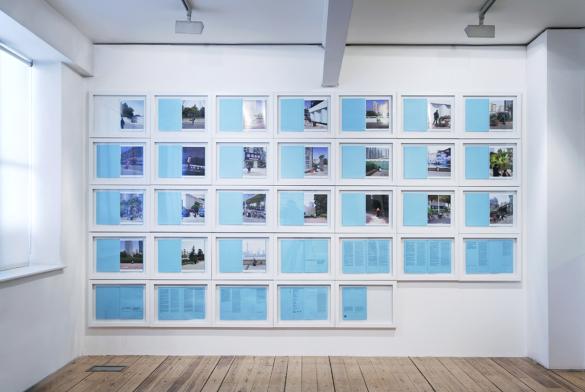Uncommon Ground at Flowers

In a city like London, it isn’t difficult to find areas known for being fashionable or artistic. In almost every corner of the city there are galleries, exhibitions and shows proudly displaying the talents of a breath-taking array of artists.
It is unique, however, to find an exhibition that feels so unlike any of the others on show at the moment, and that exhibition currently resides in Flowers, a gallery in Shoreditch.
Entitled Uncommon Ground, the exhibition aims to explore human interactions with the environment through the use of contemporary photography, and, interestingly, doesn’t define what “environment” actually means. The artists take environment in the broadest possible sense; the photographs on display span locations worldwide: anywhere from snow-covered parks and slums in Mumbai to the interior of a factory and a telephone box covered in massive post-it notes on an unnamed London street.
Uncommon Ground is about human interface with the environment, but a curious thing to note is that the photographs feature very few human subjects. Works such as Nadav Kander’s Chongqing VIII, Chongqing Municipality (2007) – a large photo of a smog-covered Jialing River, with the city of Chongqing’s form rising shadowy in the background – shows a city so massive it looms over the river, dwarfing boats and the single miniscule river-crossing in sight. The lack of people in the face of such a metropolis conveys a real sense of isolation.
Other works in the exhibition expand upon this sense of isolation: an eye-catching example being Andrea Galvani’s Higgs Ocean #12 (2010). This piece is a photograph of a person – clothed in black and facing away from the camera – standing in a boat, recording the sound of an iceberg collapsing. There is something about the piece that creates an incredible feeling of stillness. The figure is alone in the Arctic Circle with nothing but broken ice and a vast, polar expanse before it. The exhibition successfully capitalises on this unique sensation that unites the pieces by fully using the layout of the Flowers gallery, separating the works from one another, and thus the audience. Flowers is a large, empty gallery that works perfectly in alliance with the exhibition.
Perhaps the most intriguing selection of work is by collaborative duo Wassinklundgren (Thijs groot Wassink and Ruben Lundgren), and is entitled Empty Bottles (2007). The piece is a set of thirty-three prints of photographs and text detailing China’s growing informal economy of rubbish collection and recycling. The photographs show various people collecting empty plastic bottles all over China, and close to the floor is a series of panels of text – in Mandarin and English – explaining the story behind the images and the sort of people who collect rubbish for a living. Wassinklundgren explains that those involved in this economy aren’t peasants or desperate, poor people, but rather educated and inventive people who capitalise pragmatically on the opportunities available to them. Visitors are literally brought to their knees reading the story.
Uncommon Ground is an exhibition that challenges its audience in an incredibly subtle manner, and is a joy for the eyes to behold. If you get tired of the hustle and bustle of city life, the quiet open spaces of the Flowers gallery beckon, happy to challenge you and envelop you in silent reflection.
Anthony Byrne
Uncommon Ground is at Flowers until 1st September 2012.























Facebook
Twitter
Instagram
YouTube
RSS